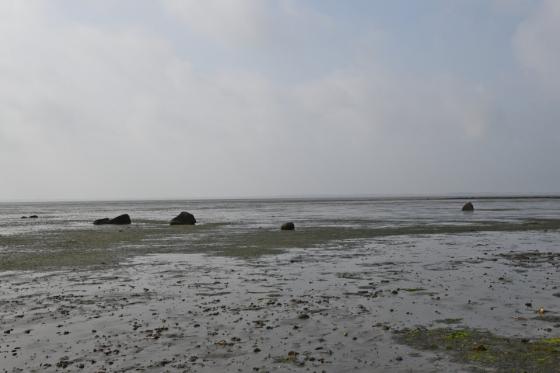taken from the on-site information board:
Denghoog
A 5000 year old burial chamber from the Neolithic Age
You are standing in front of one of the most important attraction on the island of Sylt, the Denghoog, one of the most beautiful passage graves from the younger Stone Age (4100 – 1700 BC). A period of the Funnel Beaker Culture once known as the Denghoog stage was named after him. Even the interpretation of the name Denghoog is controversial. One theory translates it as a mound with an underground chamber, a more probable one as a mound in a meadow, since 100 years ago it stood completely free in the landscape. In Sylt-Frisian (Sölring) it is referred to as Thing mound or a mound for gathering. Did our ancestors come together here in the open air to speak justice? But why then on a burial mound?
But this hill was created in the 3rd millennium BC as a burial place. Today it still rises 3.50 meters above its surroundings. At the foot it measures about 32 meters in diameter. In 1868 the mound was examined by the professor of geology Ferdinand Wibel, who found the large burial chamber hidden underneath. At a depth of about 1.20 meters – measured from the surface of the mound – you come across the capstones of the chamber, into which you can now comfortably descend from above.
Let yourself be impressed by the size of the chamber, which is laid out in the shape of an ellipse and measures five meters in an east-west direction and three meters in a north-south direction. Twelve large supporting stones form the side walls. The gaps are sealed by dry masonry made of stone tiles stacked on top of each other. Three huge capstones close the chamber at the top. The stones are all boulders that were found in the penultimate Ice Age, the Salle Ice Age, 300,000 to 130,000 BC, were transported here from Scandinavia. The corner stone on the west side of the passage clearly shows glacier cut. A layer of solid blue clay, mud fluff from the east side of the island, mixed with bowl-shaped stone debris, almost completely prevents water from entering. Above this lies a layer of yellow sand, which is finally covered at the top by a layer of humus. A corridor about six meters long and one meter high led into the burial chamber.
In addition to a healthy clay vessel, Wibel found fragments from 24 other vessels. Other grave goods included numerous stone implements such as hatchets, flat chisels and gouges, twenty flint blades, a bulb of pebbles for firing and two circular, perforated discs of 10 and 12 cm in diameter, so-called disc maces. In addition, 6 amber pearls were found, one of them in the shape of an amazon ax as well as fragments of another amber pearl. The finds are exhibited today in the Archaeological State Museum Schleswig-Holstein at Gottort Castle.
You can see casts of the most beautiful pieces in the Sylt Heimatmuseum in Keitum.
























